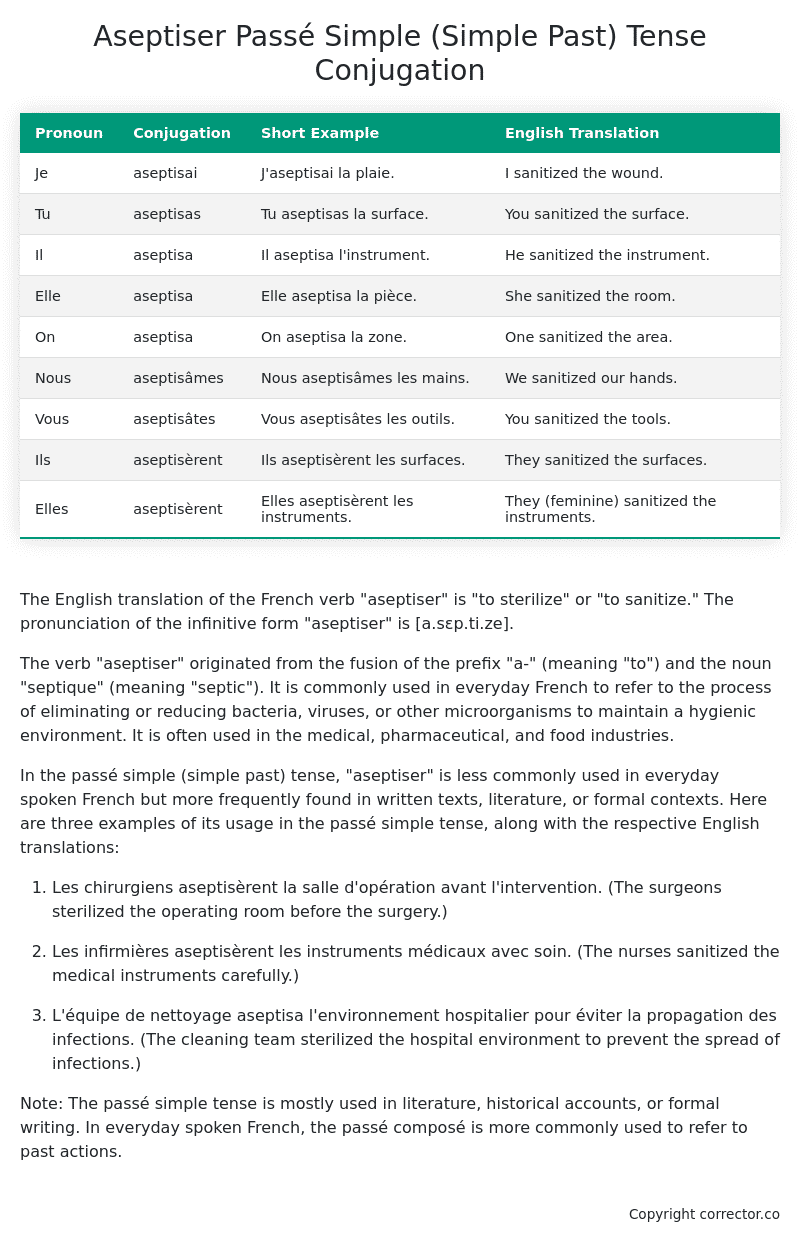Passé Simple (Simple Past) Tense Conjugation of the French Verb aseptiser
Introduction to the verb aseptiser
The English translation of the French verb “aseptiser” is “to sterilize” or “to sanitize.” The pronunciation of the infinitive form “aseptiser” is [a.sɛp.ti.ze].
The verb “aseptiser” originated from the fusion of the prefix “a-” (meaning “to”) and the noun “septique” (meaning “septic”). It is commonly used in everyday French to refer to the process of eliminating or reducing bacteria, viruses, or other microorganisms to maintain a hygienic environment. It is often used in the medical, pharmaceutical, and food industries.
In the passé simple (simple past) tense, “aseptiser” is less commonly used in everyday spoken French but more frequently found in written texts, literature, or formal contexts. Here are three examples of its usage in the passé simple tense, along with the respective English translations:
-
Les chirurgiens aseptisèrent la salle d’opération avant l’intervention.
(The surgeons sterilized the operating room before the surgery.) -
Les infirmières aseptisèrent les instruments médicaux avec soin.
(The nurses sanitized the medical instruments carefully.) -
L’équipe de nettoyage aseptisa l’environnement hospitalier pour éviter la propagation des infections.
(The cleaning team sterilized the hospital environment to prevent the spread of infections.)
Note: The passé simple tense is mostly used in literature, historical accounts, or formal writing. In everyday spoken French, the passé composé is more commonly used to refer to past actions.
Table of the Passé Simple (Simple Past) Tense Conjugation of aseptiser
| Pronoun | Conjugation | Short Example | English Translation |
|---|---|---|---|
| Je | aseptisai | J’aseptisai la plaie. | I sanitized the wound. |
| Tu | aseptisas | Tu aseptisas la surface. | You sanitized the surface. |
| Il | aseptisa | Il aseptisa l’instrument. | He sanitized the instrument. |
| Elle | aseptisa | Elle aseptisa la pièce. | She sanitized the room. |
| On | aseptisa | On aseptisa la zone. | One sanitized the area. |
| Nous | aseptisâmes | Nous aseptisâmes les mains. | We sanitized our hands. |
| Vous | aseptisâtes | Vous aseptisâtes les outils. | You sanitized the tools. |
| Ils | aseptisèrent | Ils aseptisèrent les surfaces. | They sanitized the surfaces. |
| Elles | aseptisèrent | Elles aseptisèrent les instruments. | They (feminine) sanitized the instruments. |
Other Conjugations for Aseptiser.
Le Present (Present Tense) Conjugation of the French Verb aseptiser
Imparfait (Imperfect) Tense Conjugation of the French Verb aseptiser
Passé Simple (Simple Past) Tense Conjugation of the French Verb aseptiser (You’re reading it right now!)
Passé Composé (Present Perfect) Tense Conjugation of the French Verb aseptiser
Futur Simple (Simple Future) Tense Conjugation of the French Verb aseptiser
Futur Proche (Near Future) Tense Conjugation of the French Verb aseptiser
Plus-que-parfait (Pluperfect) Tense Conjugation of the French Verb aseptiser
Passé Antérieur (Past Anterior) Tense Conjugation of the French Verb aseptiser
Futur Antérieur (Future Anterior) Tense Conjugation of the French Verb aseptiser
Subjonctif Présent (Subjunctive Present) Tense Conjugation of the French Verb aseptiser
Subjonctif Passé (Subjunctive Past) Tense Conjugation of the French Verb aseptiser
Subjonctif Imparfait (Subjunctive Imperfect) Tense Conjugation of the French Verb aseptiser
Subjonctif Plus-que-parfait (Subjunctive Pluperfect) Tense Conjugation of the French Verb aseptiser
Conditionnel Présent (Conditional Present) Tense Conjugation of the French Verb aseptiser
Conditionnel Passé (Conditional Past) Tense Conjugation of the French Verb aseptiser
Conditionnel Passé II (Conditional Past II) Tense Conjugation of the French Verb aseptiser
L’impératif Présent (Imperative Present) Tense Conjugation of the French Verb aseptiser
L’impératif Passé (Imperative Past) Tense Conjugation of the French Verb aseptiser
L’infinitif Présent (Infinitive Present) Tense Conjugation of the French Verb aseptiser
L’infinitif Passé (Infinitive Past) Tense Conjugation of the French Verb aseptiser
Le Participe Présent (Present Participle) Tense Conjugation of the French Verb aseptiser
Le Participe Passé (Past Participle) Tense Conjugation of the French Verb aseptiser
Struggling with French verbs or the language in general? Why not use our free French Grammar Checker – no registration required!
Get a FREE Download Study Sheet of this Conjugation 🔥
Simply right click the image below, click “save image” and get your free reference for the aseptiser Passé Simple tense conjugation!

Aseptiser – About the French Passé Simple (Simple Past) Tense
Formation
Usage
Narration
Historical Context
Interactions with other tenses
Passé Composé
Imparfait
Conditional and Subjunctive
Summary
I hope you enjoyed this article on the verb aseptiser. Still in a learning mood? Check out another TOTALLY random French verb conjugation!


